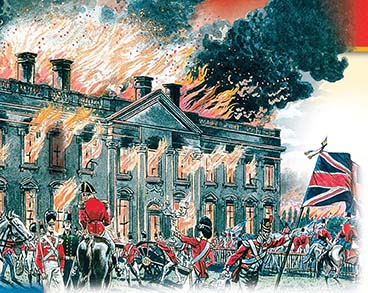SECTION 4: The War of 1812

▲ A modern-day artist re-creates the burning of the White House by the British.
WITNESS HISTORY  AUDIO
AUDIO
Burning the Capitol
In 1814, the British entered Washington, D.C., during the War of 1812. They drove President Madison and his Cabinet into the woods before burning the city. Madison’s wife, Dolley, heroically saved a painting of George Washington before joining the others. Years later, a British officer described the scene:
“Of the Senate house, the President’s palace, the barracks, the dockyard, etc., nothing could be seen except heaps of smoking ruins, and even the bridge, a noble structure upwards of a mile in length, was almost wholly demolished.”
—George Robert Gleig, 1826
Objectives
- Identify the events that led to the War Hawks’s call for war.
- Analyze the major battles and conflicts of the War of 1812.
- Explain the significance of the War of 1812.
Terms and People
- Tecumseh
- Battle of Tippecanoe
- War Hawks
- War of 1812
- Andrew Jackson
- Francis Scott Key
- “The Star-Spangled Banner”
- Battle of New Orleans
- Treaty of Ghent
- Hartford Convention
NoteTaking
Reading Skill: Recognize Sequence Record the causes of the War of 1812 in a chart like this one.

Conflict With Native Americans
- The embargo fails.
Foreign Conflict
↓
↓
Why It Matters Just a few decades after its founding, the United States found itself involved in a major war. The war tested not only the young nation’s resources and strength but the solidarity of its people as well. Despite their political divisions, Americans managed both to fight a war and to get the country back on track in the war’s aftermath. Section Focus Question: Why did the United States go to war with Britain, and what was the outcome of that war?
Gearing Up for War
Democratic Republicans felt humiliated by the failure of the 1807 embargo against Britain. With persistent British abuses on the oceans, and Native American resistance in the West, Americans increasingly blamed the British.
Replacing the Embargo
In 1809, Congress replaced the embargo with the Nonintercourse Act. Aimed at Britain and France, the act stated that the United States would resume trade with whichever of those countries lifted their restrictions on American shipping. The following year, Congress passed legislation that went a step further. Macon’s Bill No. 2 restored trade with both Britain and France but also promised that if either country actively recognized American neutrality, then the United States would resume trading sanctions against the other country. When France agreed to withdraw decrees against American shipping, President Madison ordered sanctions against the British. In the meantime, however, France continued to seize American ships.




